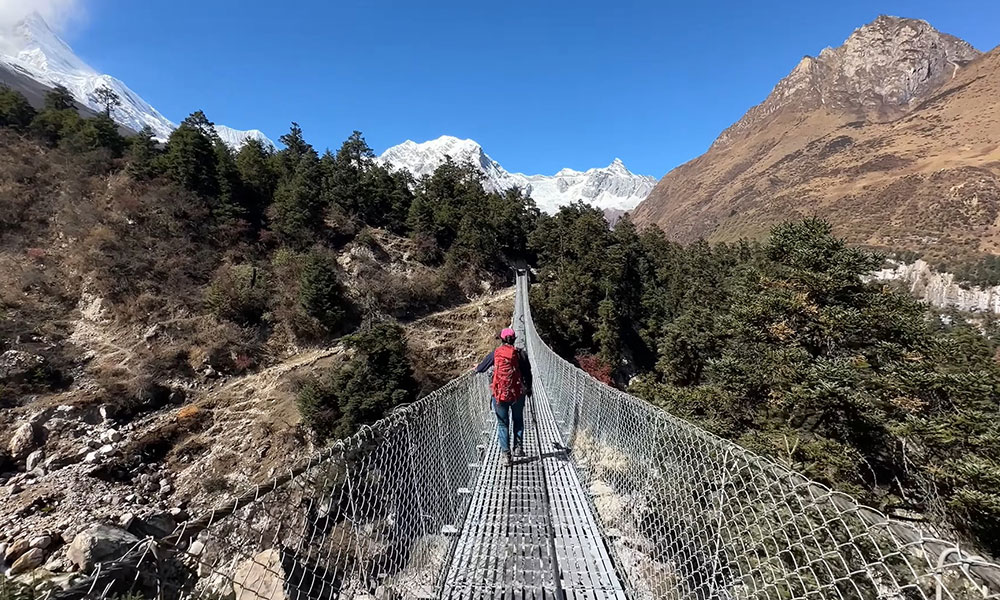
Any passionate traveler will be left awestruck while doing Manaslu Circuit Trek in September, and then after completing this wholesome journey, it might also turn fellow travelers into the storyteller of the astonishing beauty of Manaslu.
September, marking the end of the monsoons in Nepal, sprays pleasantly warm temperatures, perfect for exploring the Manaslu Circuit. However, there is a chance of little rain in early September. But as the days pass by, the weather clears up, allowing you to enjoy a journey around the world’s 8th-highest mountain, Manaslu (8,163 m (26,781 ft)).
Further, you will be thrilled to spot a glimpse of peaks such as Ngadi Chuli (7,871 m), Hiunchuli (6,441 m), Himlung Himal (7,000 m), Cheo Himal (6820 meters), Siringi Himal ((7 155m), Ganesh Himal (7,422 m), and Annapurna II (7,937 m) among others. Along with a range of great Himalayas, you encompass remote villages, Tibetan Buddhist culture, deep green forests of rhododendron and Himalayan blue pine, and Budhi Gandaki River, walking through off the beaten path.
Highlights Of Manaslu Circuit Trek in September
- Encircling the base of Manaslu (8,163 m (26,781 ft))
- Various landscapes, including the scenery of the majestic Manaslu and Annapurna range and high-altitude glacier lakes
- Cultural diversity
- Rare and endangered flora and fauna
- Walking on Great Himalaya Trail
- Crossing Larke La (5,106 m), the highest point of the Manaslu Circuit Trek
Why Manaslu Circuit Trek in September?
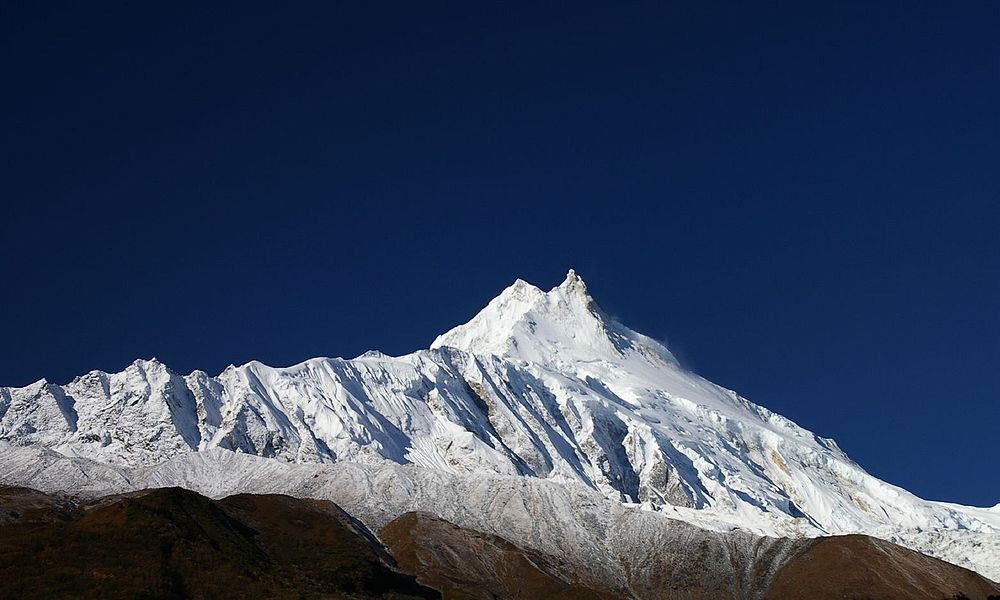
Manaslu Circuit Trek in September is a pleasant walk with a suitable temperature encircling the base of world’s 8th-highest mountain, Manaslu, feeding the eyes with magnificent views of its surrounding peaks, Himalchuli, Ngadi Chuli, and Baudha Himal.
This trek offers you to come close with the different Himalayan ethnic groups: Nubri and Tsum in the upper region while Gurung and Sherpa in the lower region scattered along the trek route. Moreover, the region is sprinkled with Buddhist religious landmarks such as Mani walls, Monasteries, and Chortens. It is widely known that the Manaslu Circuit Trek follows an ancient salt-trading route. That means you will walk into the history path once popular amidst the Himalayan Caravan.
Additionally, the Mansul circuit trek means walking in the Manaslu Conservation area, where you may surprisingly encounter a diverse range of Himalayan fauna such as Musk deer, Himalayan Serow, tahr, Marmot, Wooly Hare, Blue Sheep, and other vulnerable such as: Snow Leopard, Brown bear, Lynx, Jackal, and Red Fox etc. Besides, about 110 species of birds including Snowcock, Snow partridge, Satyr Tragopan, Kalij, Chukor partridge, and Red-headed Vulture have their natural habitat in the conserved area.
Brief Manaslu Circuit Trek Itinerary

Day 1: Arrival At Kathmandu
Day 2: Preparation day or sightseeing the valley, which is an optional
Day 3: Drive to Soti Khola(730 m): 06 hours of bus ride
Day 4: From Soti Khola trek to Machha Khola (930 m): 6 hours trekking
Day 5: From Macha Khola trek to Jagat (1,410m): 6 hours trekking
Day 6: From Jagat trek to Deng (2,130 m) through Philim (1,570 m): 6 hours trekking
Day 7: From Deng trek to Namrung (2,700 m): 05 hours of trekking
Day 8: From Namrung trek to Lo-Gaon (3,180 m): 05 hours trekking
Day 9: From Lo-Gaon trek to Sama-Gaon (3,530 m): 05 hours trekking
Day 10: At Sama-Gaon, you will have a rest day for acclimatization and local excursion.
Day 11: From Sama-Gaon trek to Samdo (3,690 m): 05 hours trekking.
Day 12: From Samdo trek to SamdoLarke Phedi / Dharmashala (4,470 m): 04 hours trekking
Day 13: Cross Larke La (5,106 m) and trek down to Bhimthang (3,790 m): 07 hours of trekking.
Day 14: Trek to Tilje (2,300 m) – 06 hours of trekking.
Day 15: Trek to Syange (1,100 m) through Jagat and Dharapani (1,725 m): 07 hours of trekking.
Day 16: Drive back to Kathmandu -07 hrs journey
Preparations for Manaslu Circuit Trek in September

Be Early Bird
Starting the trek early can be pretty much beneficial in several ways. Firstly, you can witness the beautiful sunrise over the mountain, which is absolutely breathtaking. Although there is a chance of rainfall in early September, the rainfall occurs mostly in the late afternoons and evenings.
Also, you will certainly reach your destination faster, with more spare time to relax, interact with the locals, and choose the best accommodation.
Physical Preparation
Although September brings suitable temperatures and weather, it does not change the Manaslu Circuit Trek route, which is quite difficult. With its long steep climb, this trek remains the toughest, which takes a lot of physical strength and endurance. Further, trekkers are estimated to walk 5-6 hours each day on average for up to 2 weeks. Yeah, that’s enough to exhaust anyone. That’s why you must have a good physique. Add cardiovascular exercises to your preparation routine. Avoid smoking and drinking. And most importantly, consume a healthy diet.
Mental Preparation
Mental preparation is equally significant on any journey like physical preparation, especially while trekking into the remote Himalayan trails. During your walk, you will be surrounded by magnificent landscapes and beautiful terrains. However, you may feel exhausted from the long arduous walk and feel like giving up. Remember that determination, persistence, and consistency are key factors for your trek’s success.
Trekking essentials
Be self-sufficient while grabbing trekking essentials. Research the weather and trails and pack accordingly. For Manaslu Circuit Trek in September, you will need a large backpack. First thing first, your shoe could make or break your trek. So invest in comfortable trekking boots and socks. Further, add pair of hiking pants, long a sleeve/short sleeve t-shirt, a down jacket, Winchester, gloves, underwear, scarves, a hat/cap, and don’t forget your raincoat.
Carry some medications, a first aid kit, foot powder, bandage, sunscreen, moisturizer, and lip balm. Sanitation is key while trekking, so take with your toilet paper, soap, wet tissue, toothpaste/brush, and hand sanitizer as well.
Lastly, we would recommend you use trekking poles for your walk.
See also: Manaslu Circuit Trek Packing List
Challenges of Manaslu Circuit Trek in September
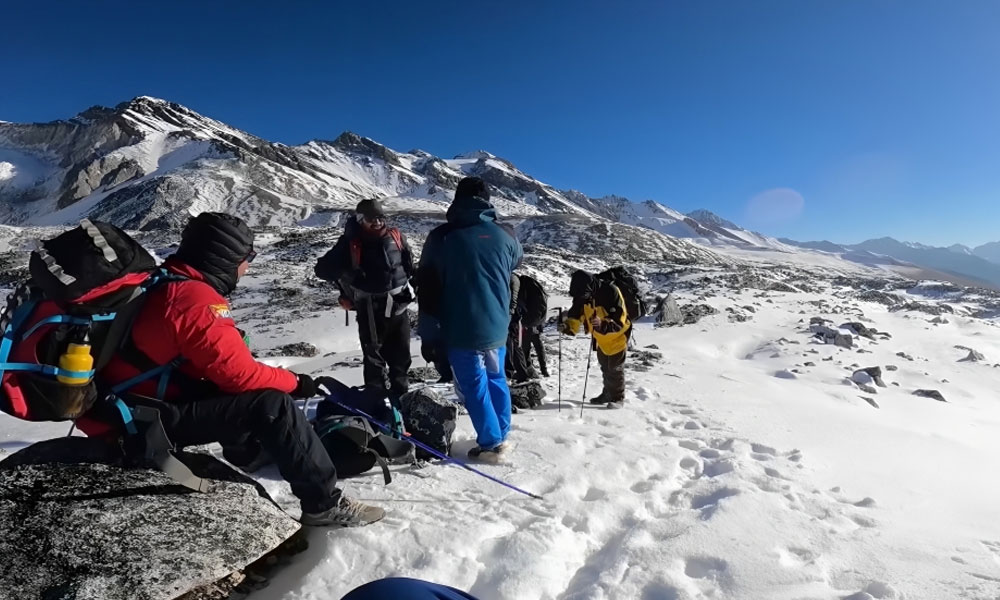
Elevation (Altitude Sickness)
During a high-altitude trek, you are at a huge risk of altitude sickness. The highest point in this circuit trek is at 5,213m in Larkya La Pass. Remember that the risk of developing altitude sickness increases, specifically when the normal human body gets over to an altitude of 2500 m above sea level.
But don’t worry; there are many ways to cope with altitude sickness. Don't push your body limit. Just take a rest wherever you are. If you feel sick or have a headache, take medicine (paracetamol, ibuprofen, promethazine). Make sure you are regularly hydrated. Avoid bad habits: like smoking and drinking alcohol. If these things do not work, quickly descend to the lower elevation. Nothing is more important than your safety and well-being.
Weather & Temperature
Manaslu Circuit Trek in September leads you from 700m to 5160m in elevation. The average day-time temperature in the lower Manaslu region is 21°C. In the mid-Manaslu region, it is 7°C at 3860m and drops even more in the higher Manaslu region. Nevertheless, mornings and nights are bitterly cold. Furthermore, there is a permanent snow line above 5,000m. That means you can walk in the milder temperature but have to add extra layers during morning and night time.
Weather in the Manaslu Circuit is not always favorable to your side. Weather can switch from a sunny day to a rainy to a stormy day.
Trails
The Manaslu Circuit Trek is considered moderately challenging. Although you don’t need any climbing skills, you have to walk in off a beaten route, steep climb up, climb down, and pass through lush forests. You would feel like leaving civilization far behind. But enjoy nature; there is nothing better.
Dehydration
Dehydration is one of the major risks while trekking in the high elevation area. From a whole day of walking and climbing in direct exposure to the sun: you sweat a lot. This is the major reason for dehydration during the trek. To treat dehydration, drink water adequately and before you feel thirsty. Further, carry snacks and water while trekking because balancing food and water greatly helps to break off dehydration. And lastly, avoid alcohol before and during your trek.
Accommodation
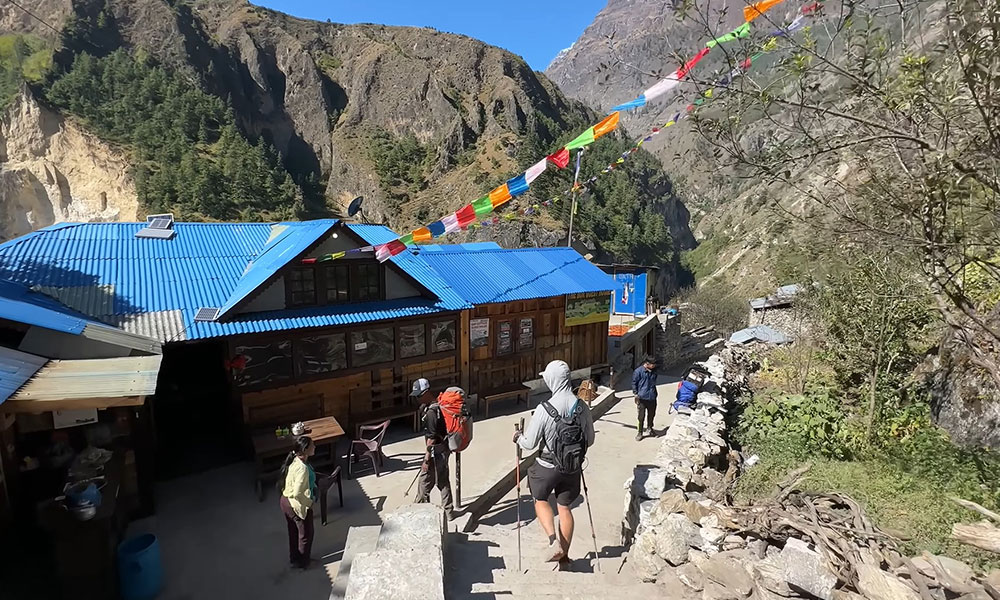
Starting from Kathmandu, our various overnight stops in the Manaslu circuit trek would be Soti Khola, Machha Khola, Jagat, Deng, Namrung, Lo-Gaon, Sama-Gaon, Samdo, Dharmashala, Bhimthang, Tilje, Syange and back to Kathmandu.
At Kathmandu, you will have a wide range of choices in accommodation from normal to 5-star hotels. After leaving the capital city, the next probable stop, according to our itinerary, is Soti Khola/Machha Khola. You can find plenty of guest houses with basic food facilities, rooms, attached bathrooms with hot showers, and wifi.
As you ascend from the Soti Khola, you can find a few teahouses with minimal facilities. Depending on the elevation, they may provide you with a hot shower and wifi but may charge you extra for the service at some tea houses.
Relevant articles you may like:
Foods & Drinks
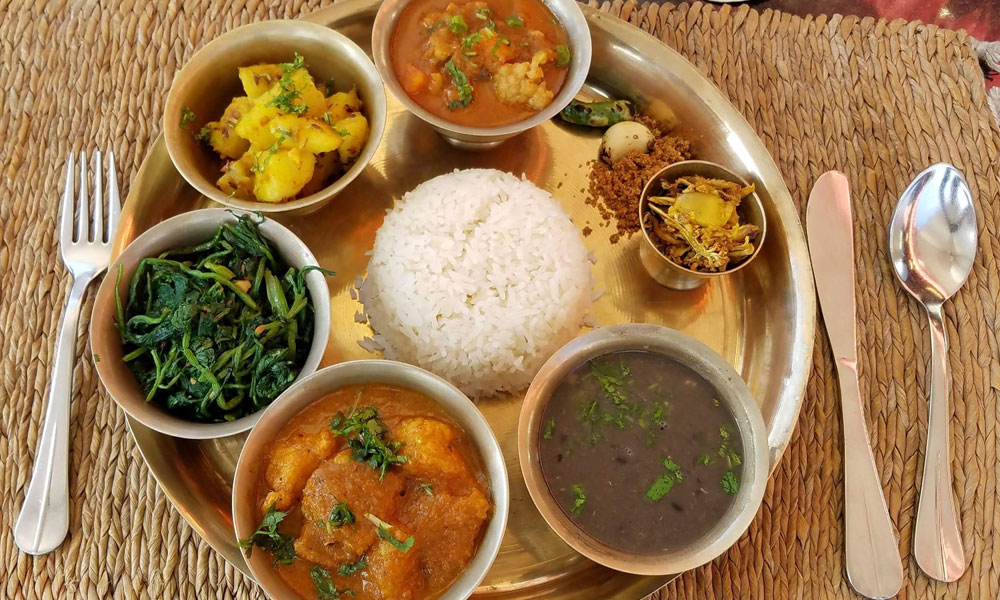
Though challenged by elevation, the teahouse at various points on the Manaslu circuit offers various foods on the menu.
Breakfast: Bread (French Toast, Toast with Butter, Jam, and Honey), Chapati, Pan Cakes, Porridge, Cornflakes, Muslies, Egg (Boiled, Omlet, & Scrambled)
Lunch & Dinner: Nepali Thali Set (Rice, Vegetables, Curry, Pickle, Pappadam, Salad, with the option of meat), Thupka (Soupy Noodles), Pasta, Spaghetti, Pizza, Sandwich, Fried Rice, and Momo, among others.
Beverage: Tea (Milk, Black, Green, Masla, & Lemon), Hot Lemon With Ginger & Honey, Hot Chocolate, Butter Tea, Juice, and others
Dessert: Pastries, Apple pie, custard pudding, rice pudding, and chocolate bars.
Snack: French Fries, Pakauda, Noodles, among others
Buying a bottle of water each time is quite expensive. So carry a bottle and refill it where you can, but treat it with purification tablets before drinking.
See more:
Electricity, Phone & Internet Access
Throughout the Manaslu Circuit Trek, electricity is available in the lower-to-mid levels, while the settlement at the higher elevation has access to solar power. So don’t panic. You don't have to spend the night with the kerosene lamps; most importantly, you can charge your phone and other accessories.
If the region has the facility of electricity, then phone networks must be available too. Yes, up to Samagaon village. After that, there are ups and downs in-network coverage. Your agency may provide the sim, or you can purchase it yourself after you arrive in Kathmandu. Many say NTC offers great coverage, but you can also choose Ncell Sim, the leading networking brand in the country.
About the Internet: you can use mobile data, or tea-house provides WIFI free at some places while the upper region generally charges you around $2-$5 for the service.
Most recently, WorldLink Communications announced high-speed internet service to Manaslu Circuit.
Permits and fees for the Manaslu Circuit trek in September
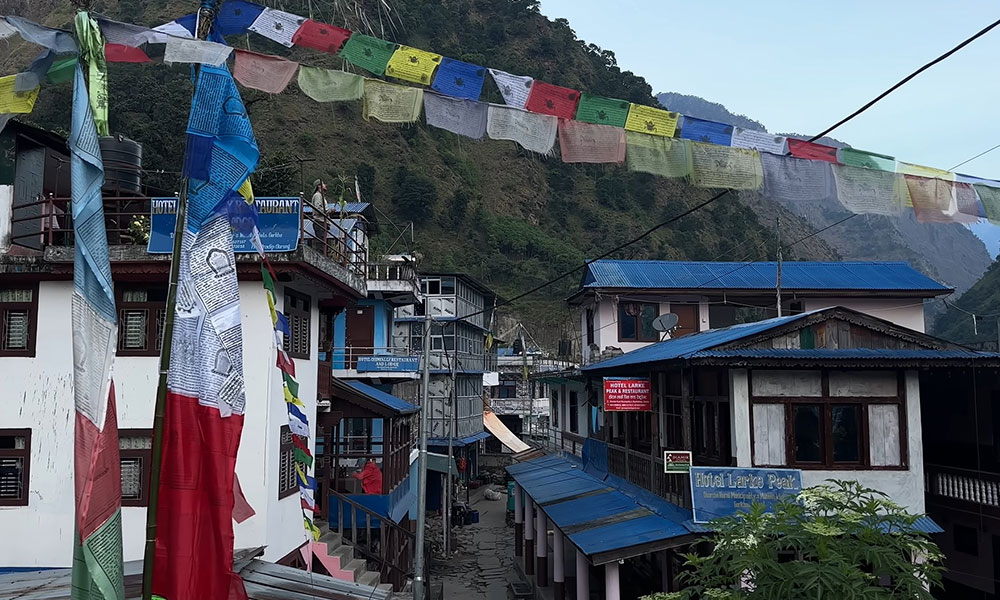
From September to November, the authorities will charge $100 for the Manaslu trek permit for the first seven days. Besides, an additional $15 will be charged for extra days in September.
Whereas, it will cost you USD 75 per person for the first seven days if you are trekking in between December and August. You will pay USD 15 per day if your stay exceeds seven days/week.
Another important permit document is Manaslu Conservation Area Permit (MCAP), which costs 1000 NPR per head for SAARC Nationals and 3,000 NPR for other Nationals.
While trekking Manaslu Circuit, you will eventually enter Annapurna Conservation Area. You will need the Annapurna Conservation Area Permit (ACAP), which costs 1,000 NPR for SAARC nationals and 3000 NPR for foreigneers.
Note: The permit is free for a child under ten.
Insurance
Trekking in Manaslu Circuit in September sometime doesn't go with our plans. Generally, trekking in a high-altitude area is inherently dangerous, so getting insurance is very important.
The first main reason for Insurance is unpredictable weather in the mountaineering area. The weather alters from bright sunny skies to dark overcast conditions with a flip of the eyes. Untimely rainfall or snowfall can be challenging for trekkers, leading to slippery trails and inviting disasters like landslides, avalanches, snowstorms, etc.
Himalayan trails are adventurous in themselves, which accidents. Further, high altitude causes altitude sickness and many other cold diseases.
So, we encourage all our clients to have insurance that covers medical evacuation, travel protection, and helicopter evacuation.
Guides & Porter

Is hiring guides mandatory? Of course, getting yourself a licensed guide has been made compulsory by the Nepal government.
Besides, trekking in the Manaslu circuit trek has secret destinations of which the trekkers are unaware. Professional guides who have been in the Manaslu Circuit numerous times are familiar with the routes and its best vantage points. They can be your new friend on your beautiful journey. Also, they take care of all of the bookings of your accommodations and permits. They are like your guardian angel.
Is a porter needed? To this point, you have already known the trekking trails and how many days you are trekking in the remote area. The choice is yours: enjoy the beautiful landscapes or carry loads of backpacks and be easily exhausted. We recommend hiring a porter. This will make your journey even more memorable, and supporting a local economy will contribute to responsible tourism.


